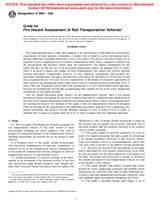Potrebujeme váš súhlas na využitie jednotlivých dát, aby sa vám okrem iného mohli ukazovať informácie týkajúce sa vašich záujmov. Súhlas udelíte kliknutím na tlačidlo „OK“.
ASTM E2061-00a
Guide for Fire Hazard Assessment of Rail Transportation Vehicles (Includes all amendments And changes 8/16/2017).
Automaticky preložený názov:
Sprievodca pre nebezpečenstvo požiaru posudzovanie koľajových Preprava
NORMA vydaná dňa 10.10.2001
Informácie o norme:
Označenie normy: ASTM E2061-00a
Poznámka: NEPLATNÁ
Dátum vydania normy: 10.10.2001
Kód tovaru: NS-44142
Počet strán: 22
Približná hmotnosť: 66 g (0.15 libier)
Krajina: Americká technická norma
Kategória: Technické normy ASTM
Anotácia textu normy ASTM E2061-00a :
Keywords:
fire hazard assessment, rail transportation vehicles, fire safety, ICS Number Code 45.120 (Equipment for railway/cableway construction and maintenance)
Doplňujúce informácie
| 1. Scope | ||||||||||||||||||||||||||||||||||||||||||||||||||||||||||||||||
|
1.1 This is a guide to developing fire hazard assessments for rail transportation vehicles. It has been written to assist professionals, including fire safety engineers, who wish to assess the fire safety of rail transportation vehicles, during or after their design (see also 1.6). This guide is not in itself a fire hazard assessment nor does it provide acceptance criteria; thus, it cannot be used for regulation. 1.2 Hazard assessment is a process that results in an estimate of the potential severity of the fires that can develop under defined scenarios, once defined incidents have occurred. Hazard assessment does not address the likelihood of a fire occurring. Hazard assessment is based on the premise that an ignition has occurred, consistent with a specified scenario, and that potential outcomes of the scenario can be reliably estimated. 1.3 Consistent with 1.2, this guide provides methods to estimate whether particular rail passenger designs provide an equal or greater level of fire safety when compared to designs developed based on the traditional applicable fire-test-response characteristic approaches currently widely used in this industry. Such approaches have typically been based on prescriptive test methodologies, as exemplified by guidelines of the Federal Railroad Administration (FRA) and recommended practices of the Federal Transit Administration (FTA) (Table X1.1). Selective use of parts of the methodology in this guide and of individual fire-test-response characteristics from Table X1.1 does not satisfy the fire safety objectives of this guide or of the table. This guide shall be used in its entirety to develop a fire hazard assessment for rail transportation vehicles or to aid in the design of such vehicles. 1.4 This guide includes and applies accepted and clearly defined fire safety engineering techniques and methods consistent with both existing, traditional prescriptive codes and standards and performance based fire codes and standards under development throughout the world. 1.5 This guide provides recommended methods to mitigate potential damage from fires in rail transportation vehicles, by assessing the comparative fire hazard of particular products, assemblies, systems or overall designs intended for use in rail transportation vehicles. Such methods could include changes to the materials, components, products, assemblies, or systems involved in the construction of the rail transportation vehicle or changes in the design features of the vehicle, including the number and location of automatically activated fire safety devices present (see 4.4.4 for further details). 1.6 This guide is intended, among other things, to be of assistance to personnel addressing issues associated with the following areas. 1.6.1 Design and specification of rail transportation vehicles. 1.6.2 Fabrication of rail transportation vehicles. 1.6.3 Supply of assemblies, subassemblies, and component materials, for use in rail transportation vehicles. 1.6.4 Operation of rail transportation vehicles. 1.6.5 Provision of a safe environment for all occupants of a rail transportation vehicle. 1.7 The techniques provided in this guide are based on specific assumptions in terms of rail transportation vehicle designs, construction and fire scenarios. These techniques can be used to provide a quantitative measure of the fire hazards from a specified set of fire conditions, involving specific materials, products, or assemblies. Such an assessment cannot be relied upon to predict the hazard of actual fires, which involve conditions, or vehicle designs, other than those assumed in the analysis. In particular, the fire hazard may be affected by the anticipated use pattern of the vehicle. 1.8 This guide can be used to analyze the estimated fire performance of the vehicle specified under defined specific fire scenarios. Under such scenarios, incidents will begin either inside or outside a vehicle, and ignition sources can involve vehicle equipment as well as other sources. The fire scenarios to be used are described in detail in Section 5.3. 1.8.1 Fires with more severe initiating conditions than those assumed in an analysis may pose more severe fire hazard than that calculated using the techniques provided in this guide. For this reason severe fire conditions must be considered as part of an array of fire scenarios. 1.9 This fire standard cannot be used to provie quantitative measures. |
||||||||||||||||||||||||||||||||||||||||||||||||||||||||||||||||
| 2. Referenced Documents | ||||||||||||||||||||||||||||||||||||||||||||||||||||||||||||||||
|




 Cookies
Cookies
